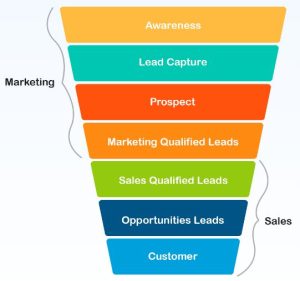What is Lead Generation?
 Lead generation is the process of attracting and capturing potential customers (leads) who have shown interest in your products or services. These leads are individuals or businesses who have expressed interest by providing their contact information, typically through forms, landing pages, or other lead capture methods.
Lead generation is the process of attracting and capturing potential customers (leads) who have shown interest in your products or services. These leads are individuals or businesses who have expressed interest by providing their contact information, typically through forms, landing pages, or other lead capture methods.
How Does Lead Generation Work?
- Identifying Your Target Audience: The first step in lead generation is to define your target audience or ideal customer profile. This includes understanding their demographics, interests, pain points, and buying behaviors.
- Creating Compelling Offers: To attract leads, you need to offer something of value in exchange for their contact information. This could be a free ebook, webinar, consultation, discount code, or any other incentive that addresses their needs or solves their problems.
- Using Multiple Channels: Lead generation can occur through various channels, including your website, social media, email marketing, search engine optimization (SEO), content marketing, paid advertising, events, and more. Using a combination of these channels allows you to reach a broader audience and capture leads at different stages of the buyer’s journey.
- Optimizing Landing Pages and Forms: Landing pages are dedicated web pages designed to capture leads by providing information about your offer and encouraging visitors to take action. Optimizing landing pages and forms for conversion is essential to maximize the number of leads generated.
- Nurturing Leads: Once you’ve captured leads, the next step is to nurture them through targeted email campaigns, personalized content, and other engagement tactics. This helps build trust, educate leads about your products or services, and move them further down the sales funnel.
- Qualifying Leads: Not all leads are ready to make a purchase immediately. Lead qualification involves assessing the readiness and suitability of leads based on factors such as their level of interest, budget, timeline, and fit with your offering.
- Handing Off to Sales: Qualified leads are passed on to the sales team for further follow-up and conversion. Effective communication and alignment between marketing and sales teams are essential to ensure a smooth handoff and maximize conversion rates.
Benefits of Lead Generation
- Increased Sales and Revenue: Lead generation helps fill your sales pipeline with qualified leads, increasing the likelihood of conversions and driving revenue growth.
- Cost-Effectiveness: Compared to traditional outbound marketing methods, lead generation is often more cost-effective, as it targets individuals who have already shown interest in your offering.
- Targeted Marketing: By focusing on attracting leads who match your ideal customer profile, lead generation allows you to tailor your marketing efforts and messaging to specific audience segments, increasing relevance and effectiveness.
- Measurable Results: With lead generation, you can track key metrics such as the number of leads generated, conversion rates, cost per lead, and ROI, providing valuable insights into the performance of your marketing campaigns.
- Building Relationships: Lead generation is not just about acquiring leads; it’s also about building relationships and nurturing trust with your audience over time. By providing value and engaging with leads throughout their buyer’s journey, you can foster long-term relationships that lead to repeat business and referrals.
Best Practices for Lead Generation
- Create Compelling Content: Offer valuable and relevant content that addresses the needs and pain points of your target audience.
- Optimize for Mobile: Ensure your lead capture forms and landing pages are mobile-friendly to accommodate users accessing your website on smartphones and tablets.
- Test and Iterate: Continuously test different lead generation tactics, offers, and messaging to identify what resonates best with your audience and optimize your campaigns for maximum results.
- Follow Up Promptly: Respond to leads promptly and follow up with personalized communication to keep them engaged and move them further down the sales funnel.
- Focus on Quality Over Quantity: While it’s important to generate a steady stream of leads, prioritize quality over quantity by focusing on attracting leads who are genuinely interested in your offering and more likely to convert into customers.
Conclusion
Lead generation is a fundamental aspect of any marketing strategy, serving as the bridge between attracting potential customers and converting them into paying customers. By implementing effective lead generation tactics, businesses can generate a steady stream of qualified leads, increase sales and revenue, and build long-term relationships with their audience. With the right strategy, tools, and ongoing optimization, lead generation can be a powerful driver of business growth and success.
FAQs
It is the practice of acquiring new customers via outbound marketing using a sales funnel. This could be paid advertising, a targeted social media campaign, an email campaign, or in-person.
Instead of waiting for folks to visit your brand (website), your website (brand) can be proactively reaching out to your target audience using.
Now you need to proactively reach out to that person to A) find out what their needs are, and B) see if your solution can help them. Use your judgement to determine if they are a qualified lead or not.
Great question! You can do this organically by utilizing SEO strategies (though this may take quite some time). If you don’t have much time (or are not patient) you can post engaging content on social media, run advertising campaigns, publish press release’s, etc.
